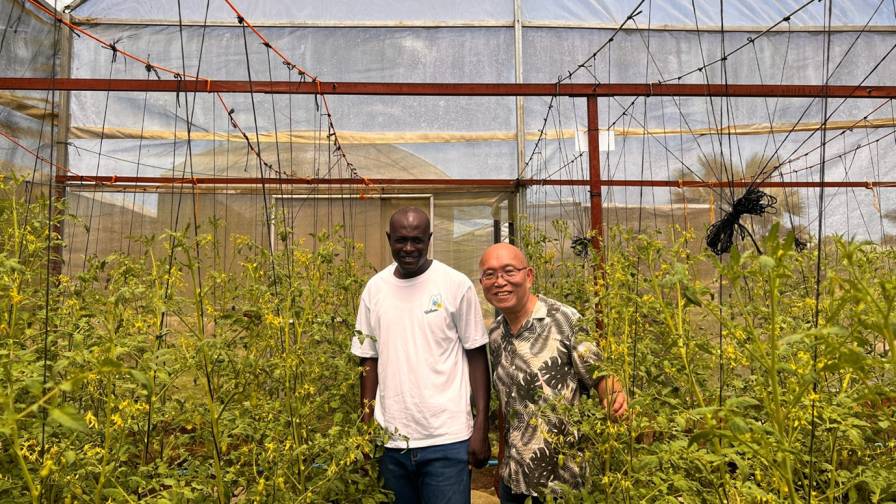Read in
Felix Kamassah (left) and CS Liew in one of the many greenhouses at Kamassah’s farm in Ghana. Photo: CS Liew
For decades Africa has been painted as poor, underdeveloped with people suffering from severe malnutrition. Charitable organizations often send letters seeking donations to save Africa and there is always a picture depicting nearly naked, skin-and-bone African children. This is true in the very arid and almost uninhabitable Sahara zone of Africa (the northern one third of the continent) where lack of rain means little food could be grown to feed tribes living in such harsh conditions. But many parts of sub-Sahara Africa (the lower two thirds of the continent) are anything but that!
Contrary to how Africa has been misrepresented with sensationalism, many countries in Africa have fertile land and good rainfall to grow crops successfully. In fact, parts of Africa, with sophisticated farming operations owned and operated by Europeans, have been feeding Europe, and soon, China. Africa has shipped lots of fresh produce to Europe, and the Chinese, having made great inroads on the continent seeking useful and valuable minerals and developing their infrastructure, are now looking to grow crops there to feed its citizens. Afterall, 60% of arable land in the world for additional food production lies in Africa.
Driving this Growing Trend
- Filling the northern hemisphere’s off-season needs: Traditionally, due to cost-advantages, fresh produce, including ornamentals, have been sourced by Europeans from Africa during the winter months to fill their supermarket shelves. The relative proximity to Europe and frequent shipping schedules between the two continents means that freight is favorable for such trade, However, in more recent times, other major factors have surfaced to make Africa an even stronger case of being a food basket for Europe.
- Climate change mitigation initiatives of the European Union (EU): Europe’s climate change mitigation strategies ― such as the desire to achieve net zero carbon emissions by 2050 have brought agricultural production and practices to the forefront for debate. One notable and recent example of governmental action is the culling of dairy cattle in Holland to reduce nitrogen oxides and ammonia emissions. Holland is the second largest food exporter after the U.S.
Pressure to reduce the agricultural carbon footprint in Holland, with the agriculture sector accounting for 16% of carbon emissions, will have significant implications on major importers of Dutch food such as Germany. Such drastic policies to hamper and curtail food production by the government by buying out farms and shutting them down will only mean higher food prices going forward. This opens up tremendous opportunities for Africa to grow and ship more food to Europe. Such golden opportunities could help Africa attain needed food security and earn valuable foreign exchange at the same time. - Farm to Fork strategy of the EU: In conjunction with climate change mitigation policies, there is also a strong push for sustainable and regenerative agriculture practices leading to the European Union’s Farm to Fork Strategy under the European Green Deal* initiative. The Farm to Fork Strategy calls for a reduction in usage of 20% and 50% respectively of chemical fertilizers and chemical pesticides by 2030.
The war in Ukraine sent shockwaves across the world in terms of spikes in food and chemical fertilizer prices slowed the implementation of the Farm to Fork Strategy somewhat but it has intensified again with the recent easing of prices. Such initiatives in the European Union have lent further support to importing more food from Africa in the years to come. - Cost of energy making indoor farming and greenhouse production prohibitive: Whatever attempts in the past to grow crops during the winter months in Europe in greenhouses and practicing indoor farming have been severely hampered by high energy prices due to the Ukraine war leading to sanctions on cheap Russian energy. Once again, Africa is the destination of choice for more fresh produce supplies to fill the gap.
Given those changing conditions, the question becomes: What will it take for African countries to succeed in being a sustainable food basket for the EU instead of always being painted as a food deficit continent, which it still is?
The first and key step is farm and farming practice compliance with EU regulations. Certification bodies and auditors are located in South Africa and Kenya.



